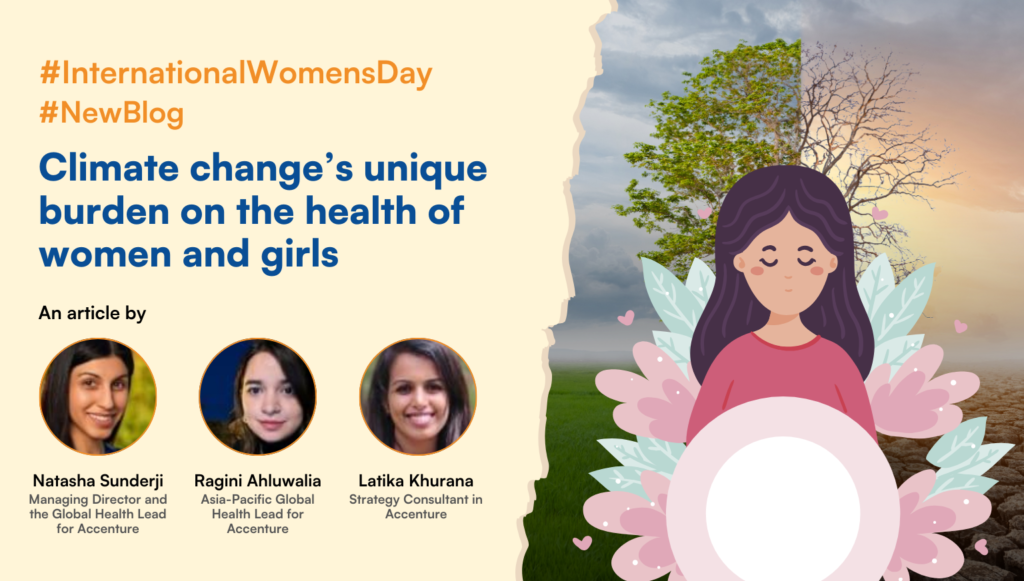


In 2024, India faced heatwaves on 28% of days during the first nine months of the year. Intensifying heatwaves are known to bring water scarcity and droughts, and have direct and indirect impacts on human health. But the impact is not gender neutral. Women and girls often bear a disproportionate impact from climate disasters. For instance, heatwaves increase the likelihoods of underweight women by 35%, child marriage by 37%, teenage pregnancies by 17% and gender-based violence by 50%.
Climate change impacts are not gender neutral
Globally, women comprise 80% of the people displaced during climate emergencies and are 14 times more likely to die during disasters, facing overall greater health risks from climate change and its devastating consequences. The increased risks women face stem from multiple access barriers including health care, education and other resources. These limitations heighten their vulnerability during and after climate-related disasters. Climate change implications can further worsen gender inequalities, reducing women’s resilience and deepening social and economic exclusion. The impact pathways of climate change on human health are intricate and complex, but to understand the higher risks for women and girls, their unique context across markets and obstacles must be examined.
Women and girls are disproportionately affected by poor access to clean water and sanitation after climate-related disasters. This lack of access ranks among the top five causes of women’s deaths globally, leading to higher rates of urinary tract infections, other bacterial infections, diarrheal diseases and menstrual hygiene issues. Prompt and safe treatments for these issues for women are often unavailable, and antibiotic misuse or increased exposure to drug-resistant pathogens escalates the global threat of antimicrobial resistance.
Substantial challenges are also encountered in accessing maternal and reproductive health care services during and after climate-related disasters. These challenges arise due to displacement, restricted access to health care facilities and disruptions in medical supply chains. For instance, in the highly flood-prone state of Assam in India, local infrastructure and facilities are often submerged and communities displaced every monsoon season. This severely restricts access to health services, leaving pregnant women and newborns particularly vulnerable. For these women, 15 Boat Clinics – mobile healthcare units on boats – operating across 13 districts in the state are the only points of care for prenatal, postnatal, neonatal and even childbirth services. However, these clinics are mostly accessible as per prior schedules as opposed to on-demand care. Such health care supply chain disruptions can also limit access to sexual and reproductive health services, resulting in unintended pregnancies, unsafe abortions, increased sexually transmitted infections and long-term consequences such as infertility.
Women and girls also often experience increased physical and mental stress as primary caregivers during adverse events. Women tend to partake in livelihoods and other responsibilities with high physical and environmental exposures, such as working in farmlands, fetching water or household cleaning and cooking. In times of climate crises, these exposures increase, advancing health risks such as vector-borne diseases, dehydration, heat strokes, or indoor air pollution. A study in Tamil Nadu, India, found that pregnant women engaging in moderate to heavy physical work had nearly doubled risks of miscarriage and adverse pregnancy outcomes due to occupational heat exposure. Climate change can further limit the educational and workforce opportunities for women and girls and increase the likelihood of child marriage and gender-based violence.
Discussions on climate and health are becoming more prominent as the number of natural disasters globally increase. However, Sustainable Development Goal (SDG) 13, which aims to address climate change and its impacts, currently does not include health- or gender-related indicators. To ensure women are protected against climate change and related disruptions to care, a comprehensive approach is required.
Gender-disaggregated data is a fundamental need for targeted and inclusive action
There continues to be a gap in the availability of gender-disaggregated data, i.e., data categorized by sex, across global and national statistics. As per the Gender Data Outlook 2024, 44% of the gender-specific data needed to measure progress on the SDGs was still missing. Recognizing the need for and advancing gender-disaggregated statistics in national programs is key to addressing gender-based health disparities, especially in low- and middle-income countries. Moreover, not only does data need to be disaggregated by gender, but also standardized in the metrics collected and granular across district, state and sub-national levels for stronger evaluation and decision-making. Mainstreaming such data requires prioritizing gender equality in data collection, analysis and policymaking. For example, one such global data alliance is working to improve the quality of and access to cross-cutting gender data. The organization is focused on addressing gaps in gender data, increasing its demand and usage, and enabling it as a lever for more gender-responsive policymaking and advocacy. Advancing such efforts for the availability of data focused on the impacts of climate change on women’s health will play a crucial role in response and resilience.
Locally-led solutions and plans that recognize gender are key
The impact of climate change on women’s health varies depending on their local contexts. Often within the same country, women and girls encounter different challenges based on varying access to food systems, housing, infrastructure, income and education opportunities, and community support. These challenges necessitate targeted adaptation-based solutions. However, national and sub-national adaptation plans and policies often do not explicitly prioritize women. For example, a study revealed 43% of state-level action plans in India did not have significant mentions of gender. A one-size-fits-all approach to climate change adaptation may not be effective. It is crucial to focus on resilience and adaptation for women’s health, tailored to their local needs and contexts.
The unique perspectives and rights of women and girls need to be heard
Women are frequently excluded from decision-making related to climate change response, which can increase their exposure to its impacts. Although there is growing awareness of the health implications of climate change, the specific challenges faced by women and girls require further attention. Including women’s perspectives in policymaking, financing, health systems strengthening, and disaster relief and response efforts is essential. For instance, the Women’s Environment and Development Organization works to incorporate women’s voices in climate change policymaking and promotes gender-responsive climate action.
Research shows that countries where women have higher social and political status generally have lower emissions and climate footprints. Women play a crucial role in climate change mitigation and adaptation. We must address the marginalization and discrimination faced by women and girls, which further heightens their vulnerability to climate change health impacts. Prioritizing gender-disaggregated data, localized resilience, and elevating women’s voices are essential in advancing more targeted research, policies, financing, leadership and community mobilization towards achieving gender equality and resilience for all.

Natasha Sunderji is a Managing Director and the Global Health Lead for Accenture Development Partnerships, with more than 20 years of experience advising multinational companies, nonprofits, foundations and multilateral agencies on growth strategy, inclusive business models, health equity and digital health. She has authored numerous articles on the future of health care and was named one of the top 50 innovators in 2020 by the World Summit AI community.

Ragini Ahluwalia is the Asia-Pacific Global Health Lead for Accenture Development Partnerships and a Senior Principal for strategy at Accenture. She has more than 12 years of experience in driving strategy, partnerships, assessments and thought leadership with global health and international development organizations with a significant focus on South Asia. She has authored several papers, including on the topics of One Health, digital health, and health equity.

Latika Khurana is a Strategy Consultant in Accenture Development Partnerships specialized the Global Health domain. She has extensive experience working with international NGOs as well as corporate foundations to support research, landscape assessment, and strategy development efforts focused on health advancement in low- or middle-income countries.
India Health Fund is registered as Confluence for Health Action and Transformation Foundation (CHATF), a Section 8
charitable company incorporated in India, supported by the Tata Trusts.